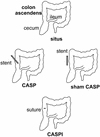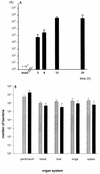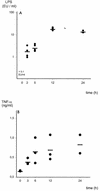Essential role of gamma interferon in survival of colon ascendens stent peritonitis, a novel murine model of abdominal sepsis
- PMID: 9573121
- PMCID: PMC108195
- DOI: 10.1128/IAI.66.5.2300-2309.1998
Essential role of gamma interferon in survival of colon ascendens stent peritonitis, a novel murine model of abdominal sepsis
Abstract
Despite considerable progress, peritonitis and sepsis remain life-threatening conditions. To improve the understanding of the pathophysiology encountered in sepsis, a new standardized and highly reproducible murine model of abdominal sepsis termed colon ascendens stent peritonitis (CASP) was developed. In CASP, a stent is inserted into the ascending colon, which generates a septic focus. CASP employing a stent of 14-gauge diameter (14G stent) results in a mortality of 100% within 18 to 48 h after surgery. By inserting stents of small diameters, mortality can be exactly controlled. Thus, CASP surgery with insertion of a 22G or 18G stent (22G or 18G CASP surgery) results in 38 or 68% mortality, respectively. 14G CASP surgery leads to a rapid invasion of bacteria into the peritoneum and the blood. As a consequence, endotoxemia occurs, inflammatory cells are recruited, and a systemic inflammatory response syndrome develops. Interestingly, the most pronounced upregulation of inflammatory cytokines (gamma interferon [IFN-gamma], tumor necrosis factor alpha [TNF-alpha] and interleukin-12) is observed in spleen and lungs. CASP surgery followed by stent removal at specific time intervals revealed that all animals survived if intervention was performed after 3 h, whereas removal of the septic focus after 9 h did not prevent death, suggesting induction of autonomous mechanisms of a lethal inflammatory response syndrome. 18G CASP surgery in IFN-gamma receptor-deficient (IFNgammaR-/-) mice revealed an essential role of IFN-gamma in survival of sepsis, whereas TNF receptor p55-deficient (TNFRp55-/-) mice did not show altered survival rates. In summary, this study describes a novel animal model that closely mimics human sepsis and appears to be highly suitable for the study of the pathophysiology of abdominal sepsis. Importantly, this model demonstrates a protective role of IFN-gamma in survival of bacterial sepsis.
Figures










Similar articles
-
Colon ascendens stent peritonitis (CASP)--a standardized model for polymicrobial abdominal sepsis.J Vis Exp. 2010 Dec 18;(46):2299. doi: 10.3791/2299. J Vis Exp. 2010. PMID: 21206468 Free PMC article.
-
Cecal ligation and puncture versus colon ascendens stent peritonitis: two distinct animal models for polymicrobial sepsis.Shock. 2004 Jun;21(6):505-11. doi: 10.1097/01.shk.0000126906.52367.dd. Shock. 2004. PMID: 15167678
-
Mechanisms of acute inflammatory lung injury induced by abdominal sepsis.Int Immunol. 1999 Feb;11(2):217-27. doi: 10.1093/intimm/11.2.217. Int Immunol. 1999. PMID: 10069420
-
Differential Paradigms in Animal Models of Sepsis.Curr Infect Dis Rep. 2016 Sep;18(9):26. doi: 10.1007/s11908-016-0535-8. Curr Infect Dis Rep. 2016. PMID: 27432263 Review.
-
Secondary Peritonitis and Intra-Abdominal Sepsis: An Increasingly Global Disease in Search of Better Systemic Therapies.Scand J Surg. 2021 Jun;110(2):139-149. doi: 10.1177/1457496920984078. Epub 2021 Jan 7. Scand J Surg. 2021. PMID: 33406974 Review.
Cited by
-
The blood-brain barrier dysfunction in sepsis.Tissue Barriers. 2021 Jan 2;9(1):1840912. doi: 10.1080/21688370.2020.1840912. Epub 2020 Dec 15. Tissue Barriers. 2021. PMID: 33319634 Free PMC article. Review.
-
The intriguing biology of the tumour necrosis factor/tumour necrosis factor receptor superfamily: players, rules and the games.Immunology. 2005 May;115(1):1-20. doi: 10.1111/j.1365-2567.2005.02143.x. Immunology. 2005. PMID: 15819693 Free PMC article. Review.
-
A Toolbox to Investigate the Impact of Impaired Oxygen Delivery in Experimental Disease Models.Front Med (Lausanne). 2022 May 16;9:869372. doi: 10.3389/fmed.2022.869372. eCollection 2022. Front Med (Lausanne). 2022. PMID: 35652064 Free PMC article. Review.
-
Bench-to-Bedside: A Translational Perspective on Murine Models of Sepsis.Surg Infect (Larchmt). 2018 Feb/Mar;19(2):137-141. doi: 10.1089/sur.2017.308. Epub 2018 Feb 2. Surg Infect (Larchmt). 2018. PMID: 29394153 Free PMC article. Review.
-
CD1d- and MR1-Restricted T Cells in Sepsis.Front Immunol. 2015 Aug 12;6:401. doi: 10.3389/fimmu.2015.00401. eCollection 2015. Front Immunol. 2015. PMID: 26322041 Free PMC article. Review.
References
-
- Abraham E, Glauser M P, Butler T, Garbino J, Gelmont D, Laterre P F, Kudsk K, Bruining H A, Otto C, Tobin E, Zwingelstein C, Lesslauer W, Leighton A. p55 tumor necrosis factor receptor fusion protein in the treatment of patients with severe sepsis and septic shock. A randomized controlled multicenter trial. Ro 45-2081 Study Group. JAMA. 1997;277:1531–1538. - PubMed
-
- Anonymous. American College of Chest Physicians/Society of Critical Care Medicine Consensus Conference: definitions for sepsis and organ failure and guidelines for the use of innovative therapies in sepsis. Crit Care Med. 1992;20:864–874. - PubMed
-
- Bach E A, Aguet M, Schreiber R D. The IFN gamma receptor: a paradigm for cytokine receptor signaling. Annu Rev Immunol. 1997;15:563–591. - PubMed
-
- Bagby G J, Plessala K J, Wilson L A, Thompson J J, Nelson S. Divergent efficacy of antibody to tumor necrosis factor-alpha in intravascular and peritonitis models of sepsis. J Infect Dis. 1991;163:83–88. - PubMed
-
- Baker C C, Chaudry I H, Gaines H O, Baue A E. Evaluation of factors affecting mortality rate after sepsis in a murine cecal ligation and puncture model. Surgery. 1983;94:331–335. - PubMed
Publication types
MeSH terms
Substances
LinkOut - more resources
Full Text Sources
Medical
Research Materials

